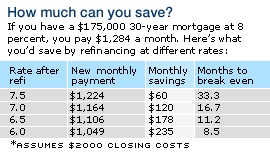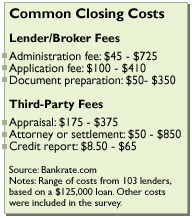NEW YORK (CNN/Money) - If you've put off refinancing because it seems too complicated, you might be missing out. Follow these steps to get in on the refinancing craze.
Find out if it's worth your while
The first step toward refinancing is research. Don't just look at how much the 30-year fixed rate has dropped and think your work is done. Because rates vary from one region to the next, you'll want to search online to find out what is competitive in your region, noting how different terms affect rates and what kinds of closing costs are attached.

An old rule of thumb was that rates needed to drop 1.5-to-2 percentage points below your existing rate before refinancing paid off. A better measure, though, is to determine how much you'll save each month by refinancing, versus how much it's going to cost you. The larger your loan, the more important every percentage point becomes. For example, if you have a 30-year loan for $300,000, lowering your rate from 7 percent to 6.5 percent will save you $100 a month and $35,000 in interest over the life of the loan.
Call your current lender
With the competition's rates in hand, call your current lender and see what it has to offer. Refinancing is usually easier, faster and cheaper if you stay with your existing lender. Most don't ask you to fill out an extensive application or hand over bank statements and tax returns. If you switch lenders, on the other hand, you will probably have to jump through many of the same hoops you did when you took out your original mortgage. "The process is much more convenient if you stick with your current lender," said Greg McBride, financial analyst for Bankrate.com.
Banks are usually pretty eager to keep your business (it costs them less to treat you well than it does to woo new customers), so don't be shy about negotiating for the better rate and lower fees. Unless your credit history is spotty, you should expect your lender to offer you a deal that's competitive with going rates. If its offer isn't on par with the competition, take your business elsewhere.
Pick your terms
Before you fully commit to a "refi," you'll want to spend some time with a mortgage calculator comparing different terms.
What kind of loan is best for you depends on how long you'll be in the house and how aggressive you want to be about paying off your loan. If you've had your current mortgage for 10 years, refinancing with a 30-year loan will certainly lower your monthly payments, but it will also put you back 10 years. A 15-year loan will reduce the interest you pay over the life of the loan but levy larger monthly payments. A 5- or 7-year ARM will get you a better rate than a 30-year fixed, but becomes an adjustable rate after five or seven years.
"Everyone is focused on the 30-year fixed, but if you don't plan on staying in a house very long you should do a 5- or 7-year ARM and take the better rate," said John Sannar, a senior loan officer for North American Mortgage.
Add up all of your costs
There is a laundry list of closing costs that could be attached to your loan, including credit report fees, appraisal fees, and document preparation fees.
Although you may not be able to get an exact tally, you should get an estimate of all your fees and weigh that against the differences in rates. Almost all fees are paid at the closing.

If you have recently refinanced with closing costs and don't think you'll be in your house very long, you might opt for no-cost refinancing, which costs nothing up front but typically raises your interest rate by one-quarter to one-half a point. "No-cost loans are pretty popular right now, especially for people with larger loans," said Chris Larsen, chief executive of E-Loan. "The larger your loan, the smaller the penalty for no-cost loans."
Conversely, if you think you'll be staying in your house for a while, consider paying points to lock in the best long-term rates. Points, which cost 1/2 of a percent-to-1 percent of the loan and are paid up front, let you buy a better interest rate. Just keep in mind that rates are already pretty low and that paying points will increase the time it takes to break even on your closing costs.
Apply already
The application process will vary depending on where you're refinancing. Many lenders will pre-approve their existing customers and ask for very little in the way of paperwork for a simple refinance. Online lenders and brokers will let you apply online, pull your credit report and give you results the same day.
Lenders typically ask you to lock in your rate after they've approved you and have gotten some form of commitment, such as permission to do an appraisal.
"You want to lock the rate in as soon as you can," said E-Loan's Larsen. "Just make sure your lock-in period is long enough to take you through the process." Some lenders promise extremely low rates, but only offer a 10-day lock-in, says Larsen. Better to opt for a longer lock-in period. What if rates decrease? Many lenders will let you "float down" part of the way. "If rates come down by more than half a point, we'll meet you halfway," said Larsen.
Closure
Before you actually close on the mortgage, your lender may request more documents from you or send more paperwork your way. Try to take care of these important details as they come up. The sooner you close, the sooner you start saving.
When it's finally time to sign on to your new, improved rate, you will need to be at the closing in person. Take heart: Most states don't require you to show up with a lawyer.

|

